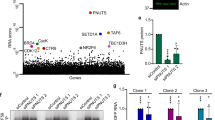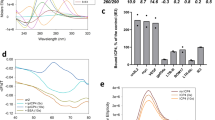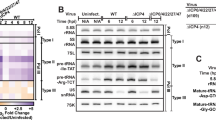Abstract
Mammalian viruses often use components of the host's cellular DNA replication machinery to carry out replication of their genomes, which enables these viruses to be used as tools for characterizing factors that are involved in cellular DNA replication. The human papillomavirus (HPV) E1 protein is essential for replication of the virus DNA1,2,3. Here we identify the cellular factor that participates in viral DNA replication by using a two-hybrid assay4 in the yeast Saccharomyces cerevisiae and E1 protein as bait. Using this assay, we isolated Ini1/hSNF5 (ref. 5), a component of the SWI/SNF complex which facilitates transcription by altering the structure of chromatin6. In vitro binding and immunoprecipitation confirmed that E1 interacts directly with Ini1/hSNF5. Transient DNA-replication assay revealed that HPV DNA replication is stimulated in a dose-dependent manner by addition of Ini1/hSNF5, and that Ini1/hSNF5 antisense RNA blocks the replication of HPV DNA. Amino-acid substitution at residues that are conserved among E1 proteins prevented the E1-Ini1/hSNF5 interaction and reduced DNA replication of HPV in vivo. Our results indicate that Ini1/hSNF5 is required for the efficient replication of papillomavirus DNA and is therefore needed, either alone or in complex with SWI/SNF complex, for mammalian DNA replication as well.
This is a preview of subscription content, access via your institution
Access options
Subscribe to this journal
Receive 51 print issues and online access
$199.00 per year
only $3.90 per issue
Buy this article
- Purchase on Springer Link
- Instant access to full article PDF
Prices may be subject to local taxes which are calculated during checkout






Similar content being viewed by others
References
Ustav, M. & Stenlund, A. Transient replication of BPV-1 requires two viral polypeptides encoded by the E1 and E2 open reading frames. EMBO J. 10, 449–457 (1991).
Del Vecchio, A. M., Romanczuk, H., Howley, P. M. & Baker, C. C. Transient replication of human papillomavirus DNAs. J. Virol. 66, 5949–5958 (1992).
Yang, L., Li, R., Mohr, I. J., Clark, R. & Botchan, M. R. BPV-1 replication in vitro is activated by the transcription factor E2. Nature 353, 628–632 (1991).
Gyuris, J., Golemis, E., Chertkov, H. & Brent, R. Cdi1, a human G1 and S phase protein phosphatase that associates with Cdk2. Cell 75, 791–803 (1993).
Kalpana, G. V., Marmon, S., Wang, S., Crabtree, G. R. & Goff, S. P. Binding and stimulation of HIV-1 integrase by a human homolog of yeast transcription factor SNF5. Science 266, 2002–2006 (1994).
Travers, A. A. The reprogramming of transcriptional competence. Cell 69, 573–575 (1992).
zur Hausen, H. Papillomavirus infections—a major cause of human cancers. Biochim. Biophys. Acta 1288, F55–F78 (1996).
Yang, L. et al. The E1 protein of bovine papilloma virus 1 is an ATP-dependent DNA helicase. Proc. Natl Acad. Sci. USA 90, 5086–5090 (1993).
Seo, Y. S., Muller, F., Lusky, M. & Hurwitz, J. Bovine papilloma virus (BPV)-encoded E1 protein contains multiple activities required for BPV DNA replication. Proc. Natl Acad. Sci. USA 90, 702–706 (1993).
Park, P. et al. The cellular DNA polymerase α-primase is required for papillomavirus DNA replication and associates with the viral E1 helicase. Proc. Natl Acad. Sci. USA 91, 8700–8704 (1994).
Mohr, I. J. et al. Targeting E1 replication protein to the papillomavirus origin of replication by complex formation with the E2 transactivator. Science 250, 1694–1699 (1990).
Laurent, B. C., Treitel, M. A. & Carlson, M. The SNF5 protein of Saccharomyces cerevisiae is a glutamine- and proline-rich transcriptional activator that affects expression of a broad spectrum of genes. Mol. Cell. Biol. 10, 5616–5625 (1990).
Peterson, C. L. & Herskowitz, I. Characterization of the yeast SWI1, SWI2, and SWI3 genes, which encode a global activator of transcription. Cell 68, 573–583 (1992).
Yasugi, T., Benson, J. D., Sakai, H., Vidal, M. & Howley, P. M. Mapping and characterization of the interaction domains of human papillomavirus type 16 E1 and E2 proteins. J. Virol. 71, 891–899 (1997).
Morozov, A., Yung, E. & Kalpana, G. V. Structure–function analysis of integrase interactor 1/hSNF5L1 reveals differential properties of two repeat motifs present in the highly conserved region. Proc. Natl Acad Sci. USA 95, 1120–1125 (1998).
Muchardt, C., Sardet, C., Bourachot, B., Onufryk, C. & Yaniv, M. Ahuman protein with homology to Saccharomyces cerevisiae SNF5 interacts with the potential helicase hbrm. Nucleic Acids Res. 23, 1127–1132 (1995).
Kingston, R. E., Bunker, C. A. & Imbalzano, A. N. Repression and activation by multiprotein complexes that alter chromatin structure. Genes Dev. 10, 905–920 (1996).
Utley, R. T., Côte, J., Owen-Hughes, T. & Workman, J. L. SWI/SNF stimulates the formation of disparate activator-nucleosome complexes but is partially redundant with cooperative binding. J. Biol. Chem. 272, 12642–12649 (1997).
Mansky, K. C., Batiza, A. & Lambert, P. F. Bovine papillomavirus type 1 E1 and simian virus 40 large T antigen share regions of sequence similarity required for multiple functions. J. Virol. 71, 7600–7608 (1997).
Clertant, P. & Seif, I. Acommon function for polyoma virus large-T and papillomavirus E1 proteins. Nature 311, 276–279 (1984).
Masterson, P. J., Stanley, M. A., Lewis, A. P. & Romanos, M. A. AC-terminal helicase domain of the human papillomavirus E1 protein binds E2 and the DNA polymerase α-primase p68 subunit. J. Virol. 72, 7407–7419 (1998).
Li, R. & Botchan, M. R. Acidic transcription factors alleviate nucleosome-mediated repression of DNA replication of bovine papillomavirus type 1. Proc. Natl Acad. Sci. USA 91, 7051–7055 (1994).
Cheng, L. & Kelly, T. J. Transcriptional activator nuclear factor I stimulates the replication of SV40 minichromosomes in vivo and in vitro. Cell 59, 541–551 (1989).
Guarante, L. Promoters and lacZ fusions designed to study expression of cloned genes in yeast. Methods Enzymol. 101, 181–193 (1983).
Gause, W. C. & Adamovicz, J. in PCR Primer: A Laboratory Manual(eds Dieffenbach, C. W. & Dveksler, G. S.) 293–311 (Cold Spring Harbor Laboratory Press, New York, (1995).
Demeret, C., Le Moal, M., Yaniv, M. & Thierry, F. Control of HPV18 DNA replication by cellular and viral transcription factors. Nucleic Acids Res. 23, 4777–4784 (1995).
Lee, D., Kim, H., Lee, Y. & Choe, J. Identification of sequence requirement for the origin of DNA replication in human papillomavirus type 18. Virus Res. 52, 97–108 (1997).
Acknowledgements
This work was supported by the Korea Science and Engineering Foundation through the Research Center for Cell Differentiation at Seoul National University and the Academic Research Fund of the Ministry of Education, Republic of Korea. J.C. holds a basic science promotion research grant from KAIST/Samsung Advanced Institute of Technology.
Author information
Authors and Affiliations
Corresponding author
Rights and permissions
About this article
Cite this article
Lee, D., Sohn, H., Kalpana, G. et al. Interaction of E1 and hSNF5 proteins stimulates replication of human papillomavirus DNA. Nature 399, 487–491 (1999). https://doi.org/10.1038/20966
Received:
Accepted:
Issue Date:
DOI: https://doi.org/10.1038/20966
This article is cited by
-
INI1/SMARCB1 Rpt1 domain mimics TAR RNA in binding to integrase to facilitate HIV-1 replication
Nature Communications (2021)
-
The Human Papillomavirus (HPV) E1 protein regulates the expression of cellular genes involved in immune response
Scientific Reports (2019)
-
Modulating the Expression Strength of the Baculovirus/Insect Cell Expression System: A Toolbox Applied to the Human Tumor Suppressor SMARCB1/SNF5
Molecular Biotechnology (2018)
-
HIV-1 replication in cell lines harboring INI1/hSNF5 mutations
Retrovirology (2006)
-
Targeting cyclin D1, a downstream effector of INI1/hSNF5, in rhabdoid tumors
Oncogene (2006)
Comments
By submitting a comment you agree to abide by our Terms and Community Guidelines. If you find something abusive or that does not comply with our terms or guidelines please flag it as inappropriate.



